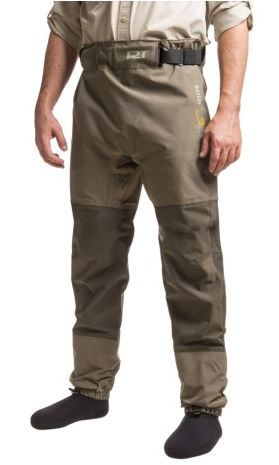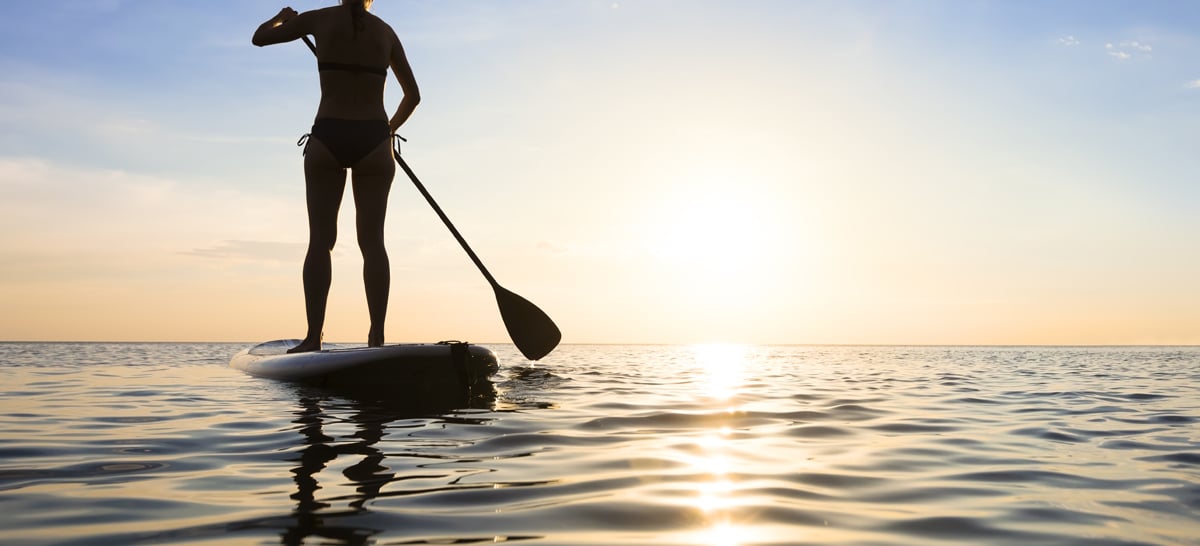
Types of Fly-Fishing Waders
Whatever water you're fishing, the type of fishing waders you choose to wear can make a world of difference in your adventure. Generally, all fishing waders fall into four basic types: bootfoot, stockingfoot, hip length and waist-high length.
Bootfoot Chest Waders

Prized on saltwater shores and among anglers who like a simple, all-in-one design, bootfoot chest waders (or "barefoot" waders) offer an easy on-off with no laces to tie or adjust. Just slip them on over a comfy pair of socks and go.
With the boot permanently attached to the wader, you save the cost of buying a separate pair of wading boots. Plus, bootfoot waders are often slightly warmer than other types because there is more air available to circulate around your legs and feet.
Bootfoot waders are heavier and bulkier than stockingfoot waders, and they usually don't come in short and tall sizes (which may be important for a proper fit while on water).
Stockingfoot Chest Waders

With a waterproof neoprene sock permanently attached, stockingfoot chest waders are designed to be worn with additional wading boots or sandals. As the wading boot gets submerged in the water, the seamless stocking and wader construction protect your feet and legs from water.
Weighing considerably less than bootfoot waders, stockingfoot chest waders come in a variety of sizes and fits and can be worn with any wader boot or sandal of your choosing. And, while this means having to buy additional wading footwear, you won't regret taking fullest advantage the support, comfort and function of this type of wading.
The lightweight, easily packable design of stockingfoot chest waders is a smart choice for traveling anglers and for walking and wading across moderate to long distances.
Hip Waders

Designed in two pieces (one for each leg), hip waders extend from the foot to the upper thigh and are intended for wading shallow, slow-moving waters. Hip waders are made in both the stockingfoot and bootfoot design and are easy to pack for traveling.
As your lightest wader option, hip waders are popular for fly fishing on warmer days because they are less constricting, allow better ventilation and offer a quick and easy on-off. You can also use a good pair of hip waders for launching and trailering boats, digging for clams and hunting in boggy terrain.
Waist-High Waders

Falling somewhere between the maximum coverage of chest waders and the minimalism of hip waders are waist-high waders. With slightly more coverage than traditional hip waders, waist-high styles are designed for wearing in water no deeper than mid-thigh. That makes them less restrictive than chest waders, as your entire upper body is exposed – perfect for warm-weather fishing.
Pro Tip: To prevent flooding your waders and dangerous mishaps, always wear a wading belt while wading in any water.
Wader Materials
All fishing waders are made from one or more of a handful of materials, including neoprene, nylon, rubber and waterproof-breathable fabrics such as Gore-Tex® and Thinsulate®.
Neoprene Waders
Measured in millimeter thicknesses, neoprene waders (made of the same material used for wetsuits) have long been a staple for cold water fishers. Waterproof insulating warmth is neoprene's biggest benefit, but it's also stretchy, durable and comes in a few different thicknesses for customizable comfort.
For moderate weather with occasional cooler days, 3mm thickness neoprene is usually adequate. For colder climates (and for hunting trips), thicker, 5mm and 7mm versions are preferred. The durable, stretchy, second-skin nature of neoprene offers better mobility while in water and will typically outlive waterproof-breathable waders. Neoprene is also highly buoyant, which is a plus for float-tube fishing.
Much like nylon and rubber, however, the big drawback for neoprene is that it's not breathable. If you start to work up a sweat, the moisture stays trapped inside (which can lead to hypothermia, if you're not careful).
Nylon Waders
Lightweight and less expensive, nylon waders are a good option for beginner fly fishers. But much like neoprene, nylon can warm up quickly and does not breathe well. This is not only a problem on warmer days, but in the effect can soak your base layer and chill your core in cooler weather, too. Nonetheless, nylon waders can be an economical means to learn how to fish in waders safely.
Rubber Waders
Heavier, bulkier and 100% waterproof, rubber waders are usually less expensive than other types. The boot components of most bootfoot waders are essentially galoshes built with rubber. Some hip waders are constructed entirely of rubber, although virtually all higher-coverage styles use additional materials. While rubber waders can be economical, they lack in breathability, flexibility and overall comfort.
Waterproof-Breathable Waders
The most versatile waders for multi-season use are waterproof-breathable waders. Constructed of either nylon or other synthetic material, these waders feature an air-permeable membrane (such as Gore-Tex®) to allow internal moisture and perspiration to escape -- even while you're in water!
In warm weather, they can be worn with shorts and a T-shirt to stay cool. During the cooler months, warmth can be added by wearing base layers. Their looser, more flexible fit, maximum breathability and multi-season versatility make waterproof-breathable waders an excellent all-around fly-fishing choice (especially for long walks to secret holes).
Pro Tip: Periodically cleaning your waders helps them breathe better and restores the durable water repellent (DWR) coating. Many stockingfoot chest waders are as easy to clean as throwing them in the washing machine on gentle cycle. Always follow the manufacturer's guidelines for cleaning your particular brand of wading boots and waders.
Wader and Wader-Boot Outsoles
The type of wading outsole your waders or wading boots are equipped with can affect both your fishing performance and personal safety while on the water. In general, there are four types of wading outsoles: felt, rubber, hiking and studded felt. These soles appear on both bootfoot waders and wading boots used with stockingfoot waders.

Felt Soles
Felt soles were once the most-popular outsoles you could find for fishing. They're less ideal on muddy bottoms and long shore walks, but they provide excellent traction on slick, rock-covered river beds. However, today it is well-known how this type of outsole can spread invasive species, such as diatoms (algea), fish parasites, fungi and tiny snails that can literally starve a stream to death. As a result, some states in the U.S. have banned the use of felt outsoles on fresh-water fisheries. If you plan to use waders or wading boots with felt outsoles, be sure to check the state laws where you'll be fishing.
Rubber Outsoles
While felt outsoles provide a grip advantage on slippery, algae-covered rocks, rubber outsoles with an aggressive tread design can offer a surprising amount of traction and stability for the majority of fishing situations. Easy to clean and less likely to spread invasive species, rubber outsoles are great for walking on muddy marshlands and fishing saltwater surfs.
Some wader boot manufacturers, such as Korkers, have designed interchangeable outsoles that can switch between felt and rubber outsoles depending on the fishing environment.
Hiking Outsoles
Hiking outsoles are often manufactured on wading boots designed for stockingfoot waders. Much like traditional rubber outsoles for waders and wading boots, hiking outsoles are very durable, offer decent traction on a variety of slick surfaces and are ideal for anglers that hike, walk and wade long distances while fishing.
Screw-in Cleats
Less ideal for muddy terrain, screw-in cleats are a great way to improve traction on slippery river bottoms with algae-covered rocks and boulders. Depending on the outsole design, screw-in cleats may be used on both felt- and rubber-soled boots. Avoid using screw-in cleats and studded felt outsoles while in a boat, as they can easily scratch and damage the boat deck.
Fishing Sandals
Fishing sandals are a lightweight alternative to wading boots. Many brands are made with quick-draining, flexible material, durable rubber outsoles and side port cutouts to shake out pebbles and sand in moving current.
A Note on Fit
Good-fitting wader and wading boots provide optimal warmth, safety and comfort. If your wading boots or waders don't fit right, you'll not only be uncomfortable, but you may tire more easily (which could lead to dangerous wading mishaps). The most common fit error is wearing waders and wading boots that fit too tightly. The best fit is not overly-baggy, but loose enough to allow you to comfortably wear base layers underneath, should you need to.



